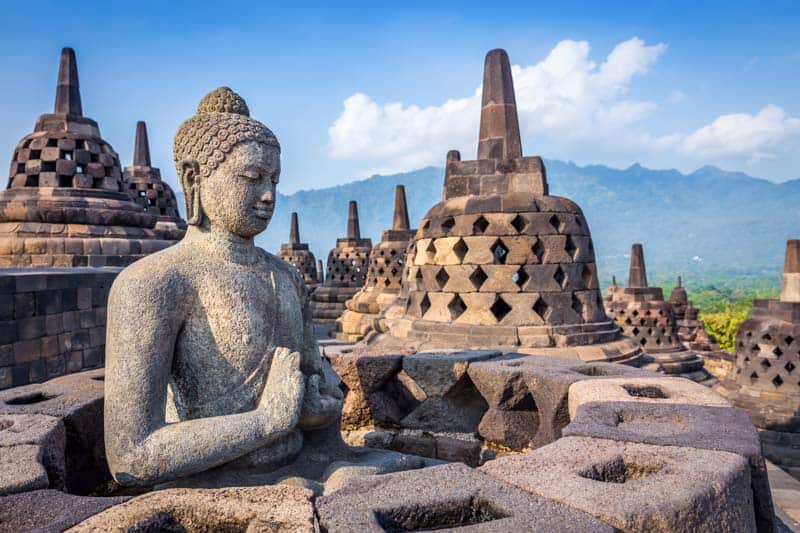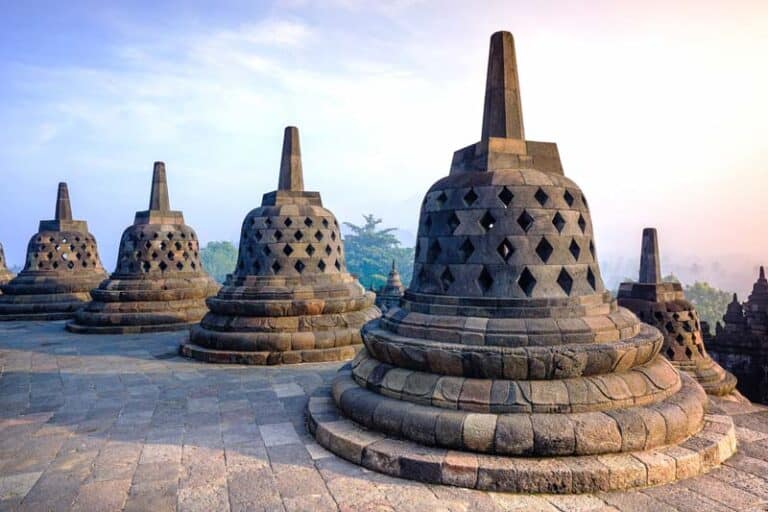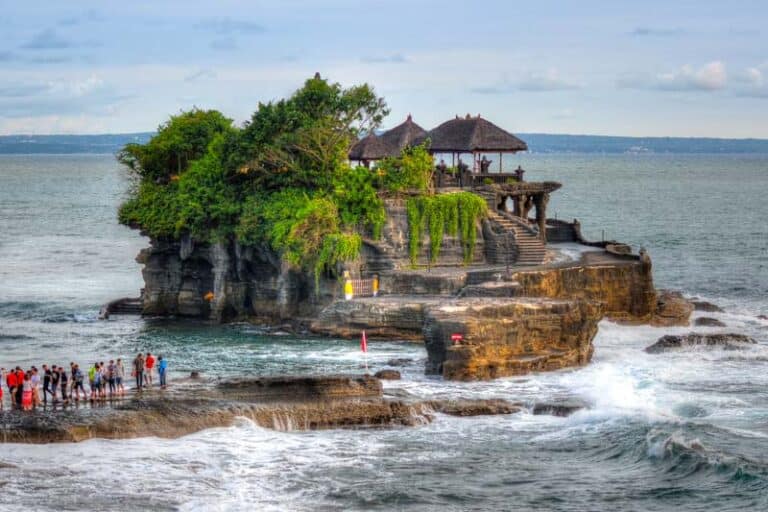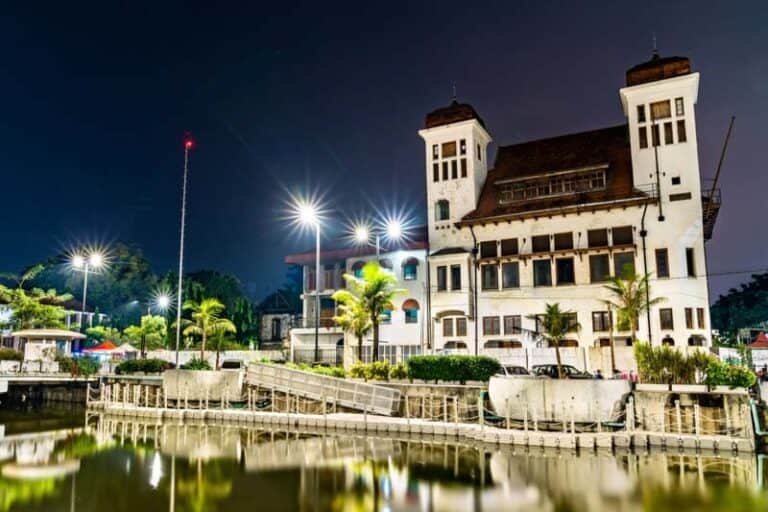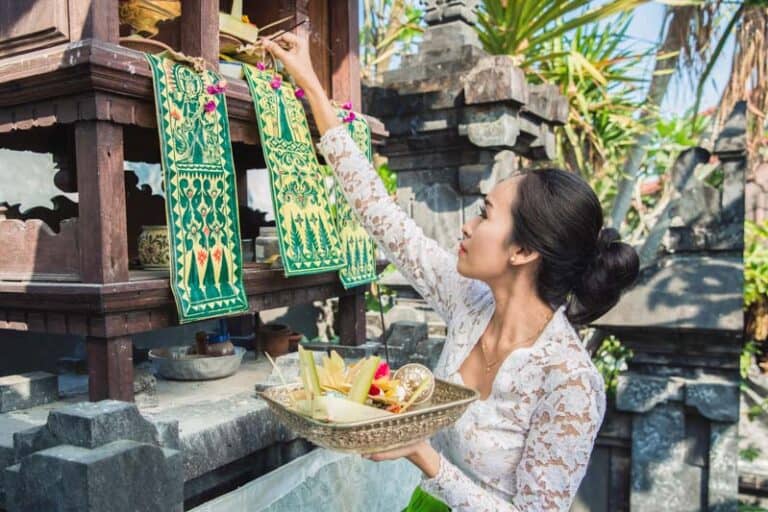What is the Borobudur Temple, and Why is it Famous?
Borobudur Temple, often hailed as Indonesia’s crown jewel, holds a special place in the world of ancient monuments. Its fame is grounded in its captivating architecture and profound spiritual symbolism.
A Glimpse into History: Borobudur Temple is a testament to Indonesia’s rich cultural heritage. Constructed during the 9th century under the patronage of the Sailendra dynasty, it serves as a colossal Buddhist monument. The temple’s unique design mirrors the path to spiritual enlightenment, with nine stacked platforms symbolizing distinct stages of the spiritual journey. As you ascend these terraces, you’ll encounter over 2,500 intricately carved relief panels and 500 Buddha statues. Each panel tells a story from Buddhist scriptures, making Borobudur a captivating repository of ancient wisdom.
A UNESCO Heritage Site: Borobudur’s historical and artistic significance has earned it a place on UNESCO’s World Heritage list. It’s a symbol of Indonesia’s rich cultural identity and a magnet for travelers seeking a profound connection with history and spirituality.
Where Is Borobudur Temple Located and How to Get There?
Where It Stands: Borobudur Temple graces the landscape near Magelang, in Central Java, Indonesia. It nestles amidst the serene surroundings of the Kedu Plain, surrounded by lush forests and rolling hills.
Journey to Borobudur: Your voyage to Borobudur typically begins in Yogyakarta, a bustling city well-connected by air to major Indonesian hubs like Jakarta and Bali. From Yogyakarta, a scenic one-hour drive takes you to Borobudur. Many travelers opt for organized tours or local drivers to ensure a hassle-free and enjoyable trip.
Best Time to Visit Borobudur Temple
The optimal time to visit Borobudur is during the dry season, which spans from April to October. During this period, you can explore the city’s many temples and historical monuments comfortably, as the weather is warm and sunny. To fully appreciate the temple’s beauty, it’s advisable to visit during daylight hours.
Borobudur can get quite crowded, especially on weekends, as it ranks among Indonesia’s top tourist attractions. To beat the crowds and enjoy the enchanting sunrise view, consider purchasing a “Sunrise at Borobudur” ticket, granting early access to the temple at 4:30 AM. If you’re staying in Yogyakarta, departing for Borobudur by 3:30 AM is recommended. These tickets are available at the reception desk of Manohara Resort, the only place offering early access to Borobudur as it resides on the temple’s grounds.
Should you prefer a guided experience and wish to delve deeper into the area’s history, hiring a local guide is a fantastic option.
Borobudur’s Must-See Highlights
As you explore the temple complex, prepare to be captivated by a wealth of highlights that make Borobudur an enchanting destination:
- Relief Panels: Over 2,500 relief panels adorn the temple, narrating stories from Buddhist texts. Among these, the “Karmawibhangga” panels stand out, depicting scenes of worldly desires and their consequences.
- Buddha Statues: Borobudur boasts numerous Buddha statues, each adorned with distinct hand gestures symbolizing different aspects of enlightenment.
- The Central Stupa: At the summit of Borobudur, you’ll find a grand central stupa, symbolizing ultimate enlightenment. Circling the stupa while making a wish is a common practice among visitors.
- Sunrise and Sunset Views: Borobudur offers breathtaking sunrise and sunset vistas, with the mist-covered Kedu Plain and the imposing Mount Merapi serving as dramatic backdrops.
Where to Stay at Borobudur Temple
Being Indonesia’s biggest tourist attraction, the Borobudur area offers a wide selection of accommodation for all budgets, and you will have plenty of choices when it comes to finding the right place to stay. You can find a great deal on accommodation by booking ahead with online travel agents or through booking.com
Practical Tips for Visiting Borobudur
- Plan Ahead: Research Borobudur’s operating hours, ticket prices, and any special events or closures. Check the official website for the most up-to-date information.
- Sunscreen and Hat: The Indonesian sun can be intense, especially if you plan to visit during sunrise or sunset. Don’t forget to pack sunscreen, a hat, and sunglasses to protect yourself from sunburn.
- Comfortable Footwear: Wear comfortable walking shoes with good grip. You’ll be climbing steep stairs and exploring the temple’s terraces, so sturdy footwear is essential.
- Stay Hydrated: Bring a refillable water bottle with you to stay hydrated, especially during hot days. There are drinking water stations near the entrance and exit.
- Photography: If you’re a photography enthusiast, ensure your camera or smartphone is fully charged and has enough storage space. Borobudur’s beauty is worth capturing.
- Cash: Bring enough Indonesian Rupiah in cash for entrance fees, snacks, and souvenirs. Many places may not accept credit cards.
- Respect Local Customs: As mentioned earlier, dress modestly and be mindful of the temple’s sacred nature. Keep noise levels down and avoid disruptive behavior.
- Local Guides: If you’re interested in a more in-depth experience, hire a local guide who can provide insights into the temple’s history and culture.
- Arrive Early: To enjoy Borobudur in a peaceful atmosphere and catch the sunrise, arrive as early as possible. The temple opens at sunrise, so aim to be there before that time.
- Bring Snacks: While there are small cafes near Borobudur, it’s a good idea to bring some snacks and water with you, especially if you plan to spend several hours exploring the temple.
- Weather Consideration: Check the weather forecast for the day of your visit and plan accordingly. Rain can be unpredictable, so carrying a small umbrella or rain poncho might be wise.
- Respect Religious Practices: If you encounter worshippers or monks during your visit, be respectful of their religious practices and avoid interrupting.
- Purchase Souvenirs Mindfully: Support local artisans by purchasing souvenirs from the on-site shops, but remember to haggle politely and avoid overpaying.
- Learn Basic Phrases: While many people in the tourism industry speak English, learning a few basic Indonesian phrases can go a long way in connecting with locals.
